Acoustic Properties of Sound Absorber from Modified Polyester with Filler Sodium Bicarbonate
Nasmi Herlina Sari1 and Jauhar Fajrin2
and Jauhar Fajrin2
1Department of Mechanical Engineering, Faculty of Engineering, Mataram University, Jl. Majapahit No. 62 Mataram, Nusa Tenggara Barat Indonesia.
2Department of Civil Engineering, Faculty of Engineering, Mataram University, Jl. Majapahit No. 62 Mataram, Nusa Tenggara Barat Indonesia
Corresponding Author E-mail: n.herlinasari@unram.ac.id
DOI : http://dx.doi.org/10.13005/ojc/3404061
Article Received on : 10-07-18
Article Accepted on : 21-07-18
Article Published : 25 Aug 2018
The combination of low price, ease of manufacturing and waterproofing characteristics has placed polyester resin as a potential sound absorbent material. Previous studies showed that adding filler material to the blending may increase the acoustics properties of a sound absorbent material. This study aims to investigate the potential of sodium bicarbonate (NaHCO3) to be employed as a filler to improve the acoustic properties of the sound absorber made of polyester resin. Two important acoustic parameters were carefully assessed; absorption coefficient and acoustic impedance. The results showed that the sound absorption performance increased significantly at low and medium frequencies in the presence of NaHCO3 filler in polyester resin. Meanwhile, the use of a back cavity on the absorbent material reduced the sound absorption performance of materials at low and medium frequencies. This suggests that sound absorber made of polyester with sodium bicarbonate filler may be used as an alternative for sound absorber materials.
KEYWORDS:Acoustic properties; Filler; Impedance Tube; Polyester; Sodium Bicarbonate
Download this article as:| Copy the following to cite this article: Sari N. H, Fajrin J. Acoustic Properties of Sound Absorber from Modified Polyester with Filler Sodium Bicarbonate. Orient J Chem 2018;34(4). |
| Copy the following to cite this URL: Sari N. H, Fajrin J. Acoustic Properties of Sound Absorber from Modified Polyester with Filler Sodium Bicarbonate. Orient J Chem 2018;34(4). Available from: http://www.orientjchem.org/?p=48716 |
Introduction
The utilization of polymer material as a sound absorber has been an option and commercially valuable. In field application, a thermoset resin material such as polyester is not recommended for a sound absorber material due to its very low sound absorption coefficient, which is less than 0.2.1 However, polyester resin has some advantages which include cheaper, easily formed, corrosion resistant, and low water absorption.2
In order to promote polymer for a sound absorber material, few researchers developed several methods to improve the acoustical properties of the polymer. Iwan et al.3 created a number of holes and configuration on the panel surface and investigated the changes in acoustics behavior due to both cavity and tube length. They reported that perforated panel (PP) achieved the best sound absorption coefficient at 0.186 in the frequency range of 522 Hz – 700 Hz, while the attachment of 18 tubes improved the sound absorption coefficient in the range of 0.248 – 0.286 at the same frequency. Further, they stated that a great improvement of absorption coefficient was achieved when every perforation equipped with a short tube to form an array of constraint short thin tubes (ACST), which was 0.6 in the frequency range of 292– 416 Hz. In addition, Sari et al.1 investigated the acoustical properties of polyester resin mixed with corn husk fiber (CHF) and found that using more polyesters in the composite decreased the sound absorption coefficient. While in contrast, the increasing of corn husk fiber in the composite increased the sound absorption coefficient (α) of composites.
Furthermore, Xie et al.4 studied the characterization of a resonator perforated with flexible tubes and found that a larger cavity depth helped to get a better absorption coefficient in low frequency. They also reported that the thickness of the panel does not affect the absorption performance, and the longer penetration brought the greater peak absorption coefficient, but higher resonance frequency. In addition, Gheorghe5 created multi-layer micro-perforated structure panels and (MPP – porous – panel). Also, Chen et al.6 compared the acoustics properties of short ramie and ramie weaved reinforced composites panels with flame retardant ammonium polyphosphate (APP), plasticizer polybutylene adipate – co – terephthalate (PBAT). They reported that the addition of flame retardant ammonium polyphosphate (APP), plasticizer polybutylene adipate – co – terephthalate (PBAT) had a positive effect on acoustic properties of PLLA/ramie fabric composites. Composites with a flame retardant are superior to composites without flame retardant. Jiang et al.7 investigated the sound absorption properties of chlorinated polyethylene composites (CPE) and seven hole polyester fiber (SHPE). They reported that fiber content, thickness, and depth cavity of the CPE/SHPF composites had significantly affected the acoustic properties. Acoustic absorption of the material increased with the increasing of SHPF content. A composite with 20% of SHPF content and 1 mm in thickness has an α value of 0.42 at a frequency range of 2500 Hz. The maximum sound absorption coefficient is obtained at a thickness of 3 mm, with a value of 0.695 at the frequency 2500 Hz.
Sodium bicarbonate (NaHCO3) is found in nature and has a special molecular structure. When this material is added to the acid (i.e. milk, vinegar) and heated to a temperature of 70oC it will release carbon dioxide (CO2). With this important characteristic, sodium bicarbonate which is currently widely used in industry such as effervescent powder may also be used in composites manufacturing. Although many investigations of using fillers in composites have been reported in the literature, the utilization of sodium hydroxide (NaHCO3) as a filler in a polymer composite to improve acoustic properties has never been reported. This article reports the experimental investigation of using sodium bicarbonate to improve the acoustic properties of the polyester resin.
Materials and Methods
Materials
NaHCO3 powder. The characteristic of NaHCO3 powder is white color, non–toxic, biodegradable and eco–friendly,8 with the following specifications; 99.0–100.5% NaHCO3, 0.2% moisture and pH (10gr/L) of 8.6. The polyester resin was obtained with a commercial type of 2250 BW–EX, which has a tensile strength of 8.8 Kg/mm2 and moduli strength of 500 Kg/mm2. Both materials, NaHCO3, and polyester are shown in Figure 1a and 1b.
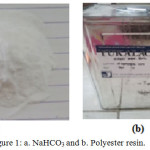 |
Figure 1: NaHCO3and b. Polyester resin.
|
Samples Preparation
The absorber materials were prepared by mixing polyester resin and NaHCO3 with a ratio of 30:70 (PN) dan 0:100 (RP) by volume fraction. The constituent materials were mixed and stirred using an impeller 500 rpm for one minute. It was expected that theoretically, the addition of NaHCO3will trigger the formation of gas bubbles which creates pores during the cooling and solidification process of the absorber materials.
There are two requirements that have to be ensured in order provide high-quality foam; the first one is to ensure a uniform distribution of NaHCO3 in a matrix, and the second is to ensure the thermal characterization of NaHCO3 to avoid the formation of cracks prior to the solidification process. Having prepared the mixture by following the above two requirements, the mixture was then stored in a constant room temperature of 25 oC to control initial drying rate before placing it in a microwave foaming for 1 minute. The microwave was set-up within intensity per unit mass of 12 kW/kg at 2.4 GHz at a temperature of 120 oC for 20 seconds. The last step was demolding and finishing. The subsequent processes of preparing sound absorption material are depicted in Figures 2 and 3.
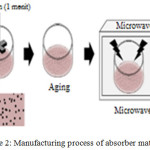 |
Figure 2: Manufacturing process of absorber materials.
|
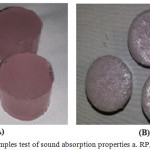 |
Figure 3: Samples test of sound absorption properties a. RP, and b. PN. Click here to View figure |
Testing method
The acoustic properties of the absorber samples were tested using impedance tubes of two microphones with the type of 4206 Brüel & Kjær, as shown in Figure 4. The samples were prepared in two thicknesses of 20 mm and 29 mm, as per ASTM E1050–98/ISO 10534–2. A small tube was prepared to measure acoustic parameters within the 100 kHz–6400 Hz frequency range, while a loudspeaker was located on one end of the tube acting as the sound source. The test sample was placed at the other end to measure the absorption properties of the sound. Two Bruel & Kjær microphones, type 4187 were positioned in front of the sample to record both sound absorption and sound reflection of the tested samples. Signals were recorded in terms of a function transferred between microphones. The collected data were further processed using a software provided by the testing machine supplier, Brüel & Kjær, to obtain the sound absorption coefficients. Each sample was replicated three times to have the average value of the measurement.
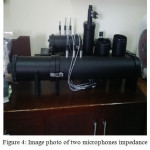 |
Figure 4: Image photo of two microphones impedance tube (Type Bruel–Kjaer 1406). |
Results and Discussions
The results of the sound absorption measurement of all tested samples are graphically presented in Figure 5. It is clearly shown that the peak sound absorption is reached within the frequency of 1300 Hz to 3100 Hz. The PN sample has the highest absorption coefficient, which is nearly 1. While, the maximum sound absorption coefficient of RP and RPcav are approximately 0.68 and 0.21, respectively. These results indicate that the addition of NaHCO3greatly improved the sound absorption performance of polyester resin. The improvement is most probably contributed by the presence of holes generated by NaHCO3 within the resin as a result of molecular opening due to the low compatibility reflection between NaHCO3 and the polyester resin. The presence of holes or cavities may convert the sound energy into thermal energy due to their friction with the molecules. This is also the reason why the sound absorption coefficient of sample PN at both low and high frequencies is higher than the others. For the panel with a thickness of 20 mm, the absorption coefficient reached a maximum value of approximately 0.8 within a frequency range of 1000 – 6000 Hz. This result is significantly higher than the value obtained by a perforated panel (PP) developed by Ian et al.3, which showed that the perforated panel using 18 tubes had a sound absorption coefficient of 0.248 – 0.286 within a frequency range of 522 Hz – 700 Hz. It proves that the NaHCO3 – polyester absorber can be a good alternative to the acoustic material.
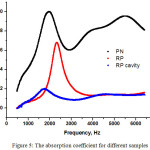 |
Figure 5: The absorption coefficient for different samples
|
It is also clearly seen in Figure 5 that the RP and RPcav samples have a low sound absorbing capabilities at high frequencies. It can be explained as follows; when a sound wave is transmitted into the RP, the sound waves are reflected and refracted causing a damping phenomenon that uses less energy and reduces heat loss, which finally results in a low sound absorption coefficient at high frequencies. This result also explains why the sound absorption coefficient of RP and RPcav samples is lower than the value obtained by the PN sample with the same pattern. The sample with a back cavity (RPcav) has the lowest coefficient of sound absorption (0.21), which indicated that the material is not appropriate as a sound absorbing the material. Sari et al.9 reported that sound absorption at lower frequencies over 1000 Hz – 3000 Hz) is desirable for automotive applications because this frequency range concurrences to the noise produced by the engine running, tires, and road, thereby making NaHCO3 – polyester absorber a promising candidate for the automotive interior sound absorber.
The real and imaginary parts of the acoustic impedance obtained from different samples are depicted in Figure 6 and 7, respectively. The real parts are the barriers attributed with energy loss, and the imaginary part is the reactance related to phase change. In this case, we can see better PN sample performance than any other material that has been studied. It is clearly indicated that the increase of sodium bicarbonate content within the polyester resin decreases the impedance value of the absorbent sample. It implies that the decreasing of the impedance value will increase the fraction of the wave energy that can be transmitted into the material. The acoustic absorption coefficient for this type of absorber can be obtained from the resultant acoustic impedance of fibrous absorbent is expressed in the equations 1, 2 and 3.10
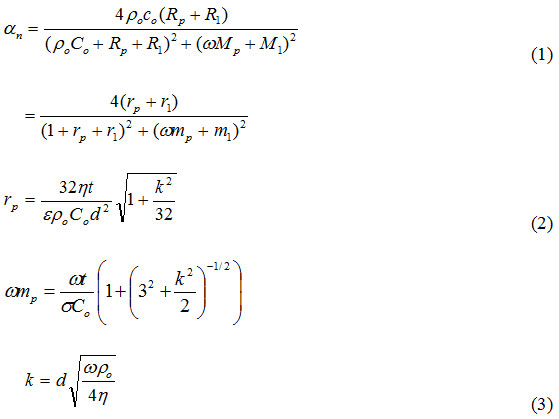
Where, is the characteristic impedance of air, k is the constant of the perforated material, ρo= 1.2 kg/m3, Co = 340 m/s, η = 1.85 x 105 kg/s/m. The RP, R1, MP, and M1 are the resistance and reactance of the perforated material, respectively, When the porosity of material ε (%), thickness of material t (mm), pores size d (mm) and frequency f is known, the surface impedance of the material can be obtained by an impedance tube.
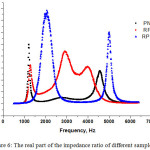 |
Figure 6: The real part of the impedance ratio of different samples. |
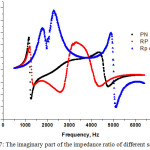 |
Figure 7: The imaginary part of the impedance ratio of different samples. |
Conclusions
Based on the measurement results, it can be concluded that the sound absorption performance is greatly increased at low and medium frequencies in the presence of NaHCO3 filler in polyester resin. The use of back cavity reduced the sound absorption performance of materials at low and medium frequencies.
References
- Sari, N. H.; Wardana, I. N. G.; Irawan, Y. S.; & Siswanto, E. Corn Husk Fiber–Polyester Composites as Sound Absorber: Nonacoustical and Acoustical Properties. Advances in Acoustics and Vibration. 2018, 15:4, 545-558. doi: 10.1080/15440478.2017.1349707.
CrossRef - Rodrigues, E. F.; Maia, T. F.; & Mulinari, D. R. The tensile strength of polyester resin reinforced sugarcane bagasse fibers modified by esterification, Procedia Engineering, 2011, 10, 2348–2352. doi:10.1016/j.proeng.2011.04.387.
CrossRef - Iwan, Y.; & Harjana. New absorption improvement strategy for QRD element. In 20th International Congress on sound & vibration. 2013, ICSV20. Bangkok, Thailand.
- Xie, H.; & Lyu, Y. Sound absorption characteristics of the perforated panel resonator with tube bundles. In The 21st International Congress on sound and vibration. 2014, ICSV 21, Beijing/China.
- Gheorghe, A. Acoustic performances analysis of a composite system for noise barriers specific to road traffic. The Annals of DUNĂREA DE JOS. 2013, University of Galati fascicle V. Technologies in machine building. ISSN 1221- 4566.
- Chen, D.; Li, J.; & Ren, J. Study on sound absorption property of ramie fiber reinforced poly (L–lactic acid) composites: Morphology and properties. Composites: Part A. 2010, 41,1012–1018. doi:10.1016/j.compositesa.2010.04.007.
CrossRef - Jiang, S.; Xu, Y.; Zhang, H.; White, C. B.; & Yan, X. Seven-hole hollow polyester fibers as reinforcement in sound absorption chlorinated polyethylene composites. Applied Acoustics. 2012, 73, 243–247. doi:10.1016/j.apacoust.2011.09.006.
CrossRef - Shakhashiri. Sodium hydrogen carbonate and sodium carbonate. Chemistry. 2010, 104–2, www.scifun.org. Retrieved from http://www.scifun.org/GenChem/CHEMWEEK/Sodium%20Bicarbonate%20and%20Sodium%20Carbonate.pdf
- Sari, N. H.; Wardana, I. N. G.; Irawan, Y. S.; & Siswanto, E. Physical and Acoustical Properties of Corn Husk Fiber Panels. Advances in Acoustics and Vibration. 2016, Article ID 5971814, 8 pages. http://dx.doi.org/10.1155/2016/5971814
CrossRef - Maderuelo–Sanz, R.; Nadal–Sisbert, A. V.; Crespo–amorós, J. E.; & Farres–Garcia, F. A novel sound absorber with recycled fibers coming from the end of life tires (ELTs). Applied Acoustics. 2012, 73(4), 402–408. doi:10.1016/j.apacoust.2011.12.001.
CrossRef

This work is licensed under a Creative Commons Attribution 4.0 International License.









